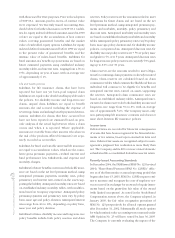American Express 2004 Annual Report Download - page 92
Download and view the complete annual report
Please find page 92 of the 2004 American Express annual report below. You can navigate through the pages in the report by either clicking on the pages listed below, or by using the keyword search tool below to find specific information within the annual report.
with those used for DAC purposes. Prior to the adoption
of SOP 03-1, amounts paid in excess of contract value
were expensed. See Recently Issued Accounting Stan-
dards below for further discussion on SOP 03-1. Liabili-
ties for equity indexed deferred annuities issued in 1999
or later are equal to the accumulation of host contract
values covering guaranteed benefits and the market
value of embedded equity options. Liabilities for equity
indexed deferred annuities issued before 1999 are equal
to the present value of guaranteed benefits and the
intrinsic value of index-based benefits. Liabilities for
fixed annuities in a benefit or payout status are based on
future estimated payments using established industry
mortality tables and interest rates, ranging from 4.6% to
9.5%, depending on year of issue, with an average rate
of approximately 6.1%.
Life and health policies
Liabilities for life insurance claims that have been
reported but have not yet been paid (unpaid claim
liabilities) are equal to the death benefits payable under
the policies. For disability income and long-term care
claims, unpaid claim liabilities are equal to benefit
amounts due and accrued, including the expense of
reviewing claims and making benefit payment determi-
nations. Liabilities for claims that have occurred but
have not been reported are estimated based on peri-
odic analysis of the actual lag between when a claim
occurs and when it is reported. Where applicable,
amounts recoverable from other insurers who share in
the risk of the products offered (reinsurers) are sepa-
rately recorded as receivables.
Liabilities for fixed and variable universal life insurance
are equal to accumulation values, which are the cumu-
lative gross premium payments, credited interest and
fund performance less withdrawals and expense and
mortality charges.
Liabilities for future benefits on term and whole life insur-
ance are based on the net level premium method, using
anticipated premium payments, mortality rates, policy
persistency and interest rates earned on the assets sup-
porting the liability. Anticipated mortality rates are based
on established industry mortality tables, with modifica-
tions based on Company experience. Anticipated policy
premium payments and persistency rates vary by policy
form, issue age and policy duration. Anticipated interest
rates range from 4% to 10%, depending on policy form,
issue year and policy duration.
Liabilities for future disability income and long-term care
policy benefits include both policy reserves and claim
reserves. Policy reserves are the amounts needed to meet
obligations for future claims and are based on the net
level premium method, using anticipated premium pay-
ments and morbidity, mortality, policy persistency and
discount rates. Anticipated morbidity and mortality rates
are based on established industry morbidity and mortality
tables. Anticipated policy persistency rates vary by policy
form, issue age, policy duration and, for disability income
policies, occupation class. Anticipated discount rates for
disability income policy reserves are 7.5% at policy issue
and grade to 5% over 5 years. Anticipated discount rates
for long-term care policy reserves are currently 5.9% grad-
ing up to 8.9% over 30 years.
Claim reserves are the amounts needed to meet obliga-
tions for continuing claim payments on already incurred
claims. Claim reserves are calculated based on claim
continuance tables which estimate the likelihood that an
individual will continue to be eligible for benefits and
anticipated interest rates earned on assets supporting
the reserves. Anticipated claim continuance rates are
based on established industry tables. Anticipated inter-
est rates for claim reserves for both disability income and
long-term care range from 3% to 8%, with an average
rate of approximately 5.2%. The Company issues only
non-participating life insurance contracts and does not
issue short duration life insurance policies.
Income taxes
Deferred taxes are recorded for future tax consequences
of events that have been recognized in the financial state-
ments or tax returns, based upon enacted tax laws and
rates. Deferred tax assets are recognized subject to man-
agement’s judgment that realization is more likely than
not. The Company and its 80% or more owned domestic
subsidiaries file a consolidated federal income tax return.
Recently Issued Accounting Standards
In December 2004, the FASB issued SFAS No. 123 (revised
2004), “Share-Based Payment (SFAS No. 123(R)),” effec-
tive as of the first interim or annual reporting period that
begins after June 15, 2005. SFAS No. 123(R) requires enti-
ties to measure and recognize the cost of employee ser-
vices received in exchange for an award of equity instru-
ments based on the grant-date fair value of the award
(with limited exceptions). As noted in the Stock-Based
Compensation section above, the Company adopted, in
January 2003, the fair value recognition provisions of
SFAS No. 123 prospectively for all stock options granted
after December 31, 2002. Substantially all stock options
for which intrinsic value accounting was continued under
APB Opinion No. 25 will have vested by June 30, 2005.
The Company is currently evaluating the impact of the
AXP
AR.04
90
Notes to Consolidated Financial Statements
























